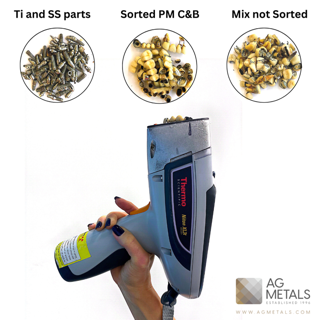How to Treat Low Grade Crowns & Bridges Dental Scrap
One of the effects of using new technologies & materials in dental restoration, is a dramatic decrease in using precious metals in crowns & bridges restorations. The use of 3D techniques such as milling, SLM (selective laser melting), 3D printing, and the fact that most of the restoration work is being done with Zirconia, CoCr alloys, Titanium, Pekkton, etc. dramatically reduces the traditional use of precious metals in dental restoration. When collecting crowns & bridges for recycling, we usually get a mix that was melted in an induction furnace into an ingot. With the precious metals content in the mixture decreasing and the casted ingot containing many components, it is very difficult to get a homogenous ingot (even when adding cooper). As a consequence, it is problematic to assay, trade and refine with it.
Therefore, the ingot may need to be dissolved and remelted, an act that makes the process longer and more expensive.

We would recommend a preliminary sorting of the lot before casting:
- Remove the screws, titanium & zirconia components from thelot.
- Assay big bridges with an “XRF gun” (HH XRF) or “laser gun” (HH LIBS) to sort out non precious alloy bridges. The more you sort, the better the result. This requires working one by one but worth the result.
At this point, it is recommended to make two castings as follows:
First ingot – from the sorted PM bridges & crowns – that will result in a nice, homogenic and rich ingot.
Second ingot – from small bridges & crowns that were not sorted.
In my experience, in crowns (“1 unit”), precious metals content is higher, so we can expect better results than if we cast everything together.
Important Notes
- As PM content in dental scrap decreases, we use this technique more often.
- I suggest making a sample sortation for every lot prior to casting in order to identify whether most of the C&Bs are non-precious. This will enable you to set expectations regarding the value of the scrap with the customer.
- Remember, a 0.5% deviation in assay of 50% concentration, is 1% difference only. A 0.5% deviation in assay of 7% concentration, is 7% difference in price!!!! This means you want to keep content as high as possible.
- HH XRF – Handheld X-Ray Fluorescence Spectroscopy.
- HH LIBS – Handheld Laser Induced Breakdown Spectroscopy.
- If an implant is attached to PM crown or bridge add it to the cast.
- There are some methods that use acids but we do not have experience with them.
- Assay just for2-3 second as yes/no answer for PM appearance.
Ami Gur
A G Metals Ltd.




